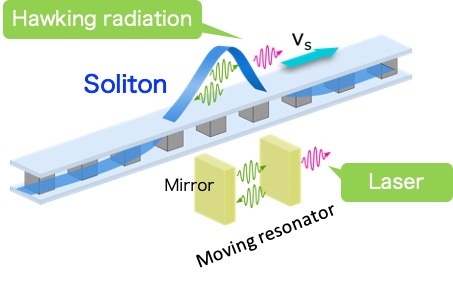Key points of this research results
- We have discovered the existence of new types of current and voltage solitons in nonlinear LC circuits, and revealed that these solitons behave as analogue black holes.
- It was found that Hawking radiation, which is difficult to observe with an actual black hole, can be observed by using an analogue black hole in this electric circuit.
- We have succeeded in constructing a black hole laser theory using analogue black holes and white holes. This further enhances the weak Hawking radiation and facilitates its observation.
Outline
The key to the unification of general relativity and quantum mechanics is the observation of Hawking radiation, which is a rare phenomenon that they encounter. However, Hawking radiation is extremely small and difficult to observe. Therefore, attempts have been made to make Hawking temperature observable by creating an analogue black hole in the laboratory system.
In electric circuits, it is possible to create an analogue black hole by introducing spatial dependence into the circuit parameters that determine the electromagnetic wave velocity. However, there was a problem with the controllability of the circuit parameters. Therefore, we have devised a new control method using solitons propagating stably in the circuit acting as an external field. We found that there are new types of current and voltage solitons in our proposed circuit, which spatially modulate the electromagnetic waves through the circuit parameters and create an analogue black hole. The Hawking temperature was found to be in the observable temperature range. (see Fig.1)
Next, we worked on the creation of a black hole laser for further amplification of Hawking radiation. Until now, it has been considered impossible with an electric circuit that does not have anomalous dispersion. Therefore, it was clarified that the soliton itself acts as a resonator by controlling the dispersion relation by the metamaterial element. As a result, the particle / antiparticle mode repeats within the soliton, and Hawking radiation is exponentially amplified by the nonlinear mode conversion. In this way, we succeeded in constructing the theory of a black hole laser for the first time in an electric circuit. (see Fig.2)

Fig1

Fig2

 Home
Home



